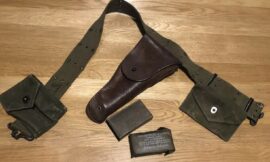The M14 rifle is a significant firearm in the history of military weaponry, known for its power, accuracy, and reliability. Adopted by the United States military in the late 1950s, the M14 served as the standard issue rifle until it was largely replaced by the M16 in the 1960s. Despite being supplanted as the main infantry rifle, the M14 has remained in service in various capacities due to its unique qualities.
Historical Background
The M14 rifle was developed in the post-World War II era as the U.S. military sought to modernize its small arms. The M1 Garand, which had been the standard rifle during World War II, was a reliable weapon but had limitations, including a fixed magazine that could only hold eight rounds. There was a push to develop a new rifle that could incorporate a detachable magazine and select-fire capability.
Development began with the T20, an experimental version of the M1 Garand, which eventually led to the T44 prototype. After rigorous testing and evaluation, the T44 was officially adopted as the M14 in 1957. The M14 was chambered for the 7.62×51mm NATO cartridge, providing a powerful and versatile round suitable for both automatic and semi-automatic fire.
Design and Features
The M14 rifle is a gas-operated, air-cooled, magazine-fed, shoulder-fired weapon. Key features of the M14 include:
- Gas System: The M14 utilizes a gas-operated system with a rotating bolt. This system is derived from the M1 Garand’s reliable gas mechanism but improved for better performance and ease of maintenance.
- Cartridge: Chambered for the 7.62×51mm NATO cartridge, the M14 offers significant stopping power and range. This cartridge is effective for both standard infantry use and designated marksman roles.
- Select Fire: The M14 has a selector switch that allows the operator to choose between semi-automatic and fully automatic fire. However, in practice, the fully automatic mode was often found to be difficult to control due to the rifle’s powerful cartridge and weight.
- Magazine: The rifle features a detachable box magazine, typically holding 20 rounds. This was a significant improvement over the fixed magazine of the M1 Garand.
- Construction: The M14 is made from high-quality materials, with a wooden or fiberglass stock and steel components. This construction contributes to its durability and reliability in various conditions.
- Accuracy: The M14 is known for its accuracy, aided by its long sight radius and the ballistic properties of the 7.62×51mm NATO round. This made it a preferred choice for marksman and sniper roles.
Variants
Several variants of the M14 have been developed to meet different operational needs:
- M14A1: A variant designed for automatic fire, featuring a pistol grip and a folding forward grip to help manage recoil. It also includes a bipod for stabilized shooting.
- M21: A sniper rifle variant of the M14, equipped with a match-grade barrel and a scope. The M21 was used extensively during the Vietnam War.
- M14 EBR (Enhanced Battle Rifle): A modernized version with a modular stock system, Picatinny rails for mounting accessories, and improved ergonomics. The EBR is used by U.S. Navy SEALs and other special forces units.
Military and Law Enforcement Use
The M14 was the standard issue rifle for the U.S. military from 1959 to 1964, when it was officially replaced by the M16. However, the M14 continued to see service in various capacities due to its reliability and power. It was particularly valued in roles where range and accuracy were paramount, such as in designated marksman and sniper roles.
During the Vietnam War, the M14’s long-range capabilities were highly valued in the dense jungle environments. In more recent conflicts, the M14 and its variants have been re-deployed in both Iraq and Afghanistan, where the need for longer-range engagement has revived its utility.
Performance
The M14’s performance is characterized by its powerful cartridge, accuracy, and reliability. The 7.62×51mm NATO round provides effective range and stopping power, making the M14 suitable for both offensive and defensive roles. Its robust construction ensures reliable operation in adverse conditions, although its weight and recoil in fully automatic mode can be challenging for some users.
Conclusion
The M14 rifle holds a distinguished place in the history of military firearms. Its combination of power, accuracy, and reliability made it a valuable asset during its service as the standard issue rifle and continues to ensure its relevance in specialized roles today. Whether as a battle rifle, a designated marksman rifle, or a sniper platform, the M14’s enduring legacy is a testament to its effective design and versatile performance.


